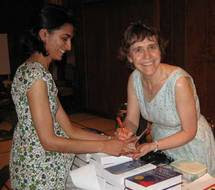Ginger has been a valued spice for a very long time, so it is not surprising that its name goes back all the way to Sanskrit. The Sanskrit name srngavera was influenced by their word for "horn", srnga, because ginger root looks like an antler.

By the time the thing and the word had travelled as far as Britain, in the Middle Ages, it got simplified to gingifer and then to ginger.
The word started to be applied to a light sandy ginger-like colour, especially of hair, in the 19th century, but since then I would say it is applied to darker oranges, as all redheads tend to be called "ginger".
Here's our neighbourhood huge fluffy ginger tom, Nemo, who likes to wander into my office without so much as a by-your-leave.
There's another ginger cat in my neighbourhood who goes by the name "Mackintosh". What a brilliant name! (For those of you in the US, Mackintosh is a brand of toffee that is available in Britain in Canada, but not in the States, I believe).
A word I find quite delightful for an orange cat with white markings, especially on the front, is the "creamsicle" cat.

For those of you who don't live in North America, Creamsicle is the brand name here of a popsicle that is orange ice on the outside encasing vanilla ice cream in the middle:
The earliest example of "creamsicle cat" I can find on the web is from 2001. I remember taking a quotation for it (and being delighted by it) in a novel by Canadian author Douglas Coupland when I was doing research for the Canadian Oxford Dictionary. I think the novel in question was Girlfriend in a Coma, which dates from 1998, so perhaps we can credit Coupland with this invention.
"Gingerly", by the way, has nothing to do with ginger. At its origins in English, in the 1500s, "gingerly" was probably an adverb used in dancing to mean "daintily, delicately, with small, elegant steps". It came from a French word gensor (pretty or graceful), in turn derived from the Latin gent (aristocratic), which has also given us genteel. There has always been this association between noble birth and refined manners and movement, so originally if you said someone danced gingerly, it was a compliment, but gradually it came to have derogatory overtones of mincing, until finally it came to apply (as an adjective rather than an adverb) to any motion that is timid, wary, or tentative. It could be said that I always dance gingerly in my ballet classes, not because I look aristocratic, but because I am always afraid of falling over!
For the origins of the word "tabby", click here.
I love ginger, and in particular I love ginger crinkle cookies, and since I haven't given you a recipe in at least a week, here's my favourite one (for another recipe using ginger, try my cantaloupe cake).
2 cups sifted flour
2 tsp baking soda
1 tsp cinnamon
1 teaspoon cloves
1 teaspoon ginger
1 cup sugar
3/4 cup butter or margarine
1/4 cup molasses
1 egg
Sift together dry ingredients. Beat butter and sugar till light and fluffy, 3-5 minutes. Blend in molasses and egg and beat for another minute. Beat in dry ingredients on low speed. Refrigerate at least one hour.
Preheat oven to 350 degrees.
Using a tablespoon measuring spoon, form balls of dough, and roll in sugar.
Place 2 inches apart on parchment-paper lined cookie sheets. Bake 12 -14 minutes; remove when still just a little soft in the middle. Let cool on the cookie sheet then remove to a wire rack.
YUMMMMM!
(you can replace half the all-purpose flour with whole wheat flour; a bit of fibre, and no-one will notice. Heck, with the iron from the molasses and the antioxidants from the spices, you can even delude yourself that you are eating something healthy!)


Looking outside of English, we find that the original Sanskrt word had an interesting journey through other Indo-European languages. You could almost use it as introduction to phonetics and a summary of sound change. http://gernot-katzers-spice-pages.com/engl/Zing_off.html
ReplyDelete[dʒ]